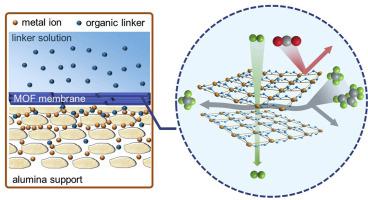当前位置:
X-MOL 学术
›
J. Membr. Sci.
›
论文详情
Our official English website, www.x-mol.net, welcomes your
feedback! (Note: you will need to create a separate account there.)
In-situ interfacial assembly of ultra-H2-permeable metal-organic framework membranes for H2/CO2 separation
Journal of Membrane Science ( IF 8.4 ) Pub Date : 2020-10-01 , DOI: 10.1016/j.memsci.2020.118419 Kun Yang , Yujie Ban , Ang Guo , Meng Zhao , Yingwu Zhou , Na Cao , Weishen Yang
Journal of Membrane Science ( IF 8.4 ) Pub Date : 2020-10-01 , DOI: 10.1016/j.memsci.2020.118419 Kun Yang , Yujie Ban , Ang Guo , Meng Zhao , Yingwu Zhou , Na Cao , Weishen Yang

|
Abstract H2/CO2 splitting is one of the most urgently demanded but challenging technologies in industry. Ultra-H2-permeable metal-organic framework (MOF) membranes with high selectivity show great promise for energy-efficient separations, but a huge obstacle is the deficiency of facile and reliable fabrications to control the orientation and thickness of membranes that determines mass-transfer characteristics. We demonstrate the fabrication of layered Zn2(bim)4 membranes by means of an in-situ interfacial assembly (ISIA) approach involving the impregnation of limited zinc ions into the pores of a support under controlled negative pressure and the tuning of metal-linker reactions at the interface to achieve the well-matched nucleation and epitaxy growth. The ultrathin c-oriented membranes with disordered layer-by-layer stacking microstructure in crystallography achieve H2 permeances of 6300-10680 GPU and H2 selectivity toward CO2 of up to 86.5, far exceeding the Robeson’s upperbound for H2/CO2 separation.
中文翻译:

用于 H2/CO2 分离的超透 H2 金属有机骨架膜的原位界面组装
摘要 H2/CO2 裂解是工业中需求最迫切但最具挑战性的技术之一。具有高选择性的超 H2 渗透金属有机框架 (MOF) 膜显示出节能分离的巨大前景,但一个巨大的障碍是缺乏简便可靠的制造方法来控制决定传质的膜的取向和厚度特征。我们展示了通过原位界面组装 (ISIA) 方法制造层状 Zn2(bim)4 膜,该方法涉及在受控负压下将有限的锌离子浸渍到载体的孔中并调节金属-连接体反应在界面处实现良好匹配的成核和外延生长。
更新日期:2020-10-01
中文翻译:

用于 H2/CO2 分离的超透 H2 金属有机骨架膜的原位界面组装
摘要 H2/CO2 裂解是工业中需求最迫切但最具挑战性的技术之一。具有高选择性的超 H2 渗透金属有机框架 (MOF) 膜显示出节能分离的巨大前景,但一个巨大的障碍是缺乏简便可靠的制造方法来控制决定传质的膜的取向和厚度特征。我们展示了通过原位界面组装 (ISIA) 方法制造层状 Zn2(bim)4 膜,该方法涉及在受控负压下将有限的锌离子浸渍到载体的孔中并调节金属-连接体反应在界面处实现良好匹配的成核和外延生长。


















































 京公网安备 11010802027423号
京公网安备 11010802027423号